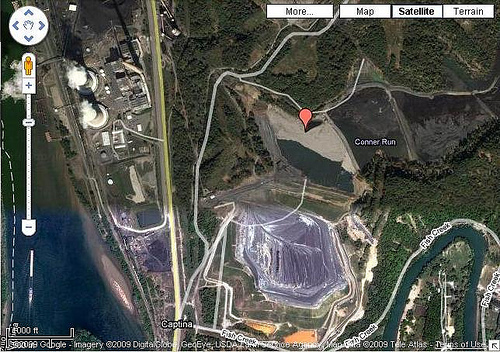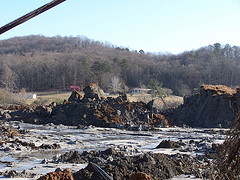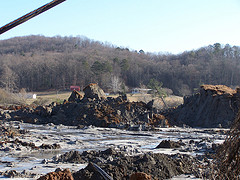This is the weekly post from Bruce Nilles, director of Sierra Club’s Beyond Coal Campaign.
The public’s right-to-know scored a victory this week when the Environmental Protection Agency (EPA) finally released the list of the 44 coal ash sites deemed “high hazard.” This comes two weeks after a coalition of organizations including the Sierra Club filed a Freedom of Information Act request demanding the release of the list.
Since then we’ve been crunching some numbers to learn more this list of coal ash storage sites. First of all, we’ve put the 44 sites onto Google Maps so you can see just how close you are to one.
Here’s an example of one of the sites. 
Moundsville, WV coal pond The “high hazard potential” coal ash storage sites listed by EPA are all located near coal-fired electric power plants concentrated in 10 states; with 12 sites in North Carolina and nine sites in Arizona alone. We also see many of the same energy offenders in the release: Topping the list with 11 sites electric utility giant American Electric Power, followed closely by Duke Energy and Arizona Electric Power Cooperative.
After doing some demographic research on these locations, we’ve also noticed that 20 of the coal ash storage sites are in areas where high percentages of people live below the poverty line (some sites have more than one pond). For example, in Louisa, Ky., where the Big Sandy coal ash storage site operated by American Electric Power is located, more than 29% of the community lives below the poverty line.
For some perspective, more than 12% of Americans nationwide live below the poverty line.
Another example is the coal ash site located at Allegheny Power’s Pleasants Power Station near Willow Island, West Virginia. There, more than 20% of the community lives below the poverty line. Yet another example comes from the site with the most coal ash storage ponds in one location: Cochise, Arizona, with its eight storage ponds at the Apache Station operated by Arizona Electric Power Corporation. In Cochise, more than 19% of residents live below the poverty line. (All our city data comes from the 2000 Census)
Coal ash impoundments were placed on this EPA list based on the potential for harm to surrounding communities in the event of an accident, but at the request of the Department of Homeland Security and the Army Corps of Engineers, the agency had previously refused to release the information.
It’s important to point out that these sites are listed as hazardous due to the location and condition of the dams, NOT because of the pollution stored behind them and whether or not it is seeping out into local drinking water. These 44 sites are places where a dam failure would likely result in a loss of life. We still don’t know just how many of the hundreds of coal ash sites nationwide are leaking toxic pollution into local drinking water supplies, but evidence is mounting that dozens of communities are living with that nightmare every day.

The TVA dam breach disaster from last December
The next step is to clean these sites up expeditiously, so that they no longer present a hazard to downstream communities. At the same time, EPA must move forward to close the regulatory loopholes that the coal industry has enjoyed for far too long. It is time to require the coal industry to treat coal ash as the hazardous waste that it is.
Tell your Senator to push for coal ash regulations.
Announcing these high hazard coal ash storage sites also underscores the need to move beyond the dirty energy sources of the past. It’s time to get America running on clean energy. Instead of the toxic legacy of America’s dirty energy past, the clean energy future promises millions of new jobs, healthier communities, and a safer climate for future generations.





